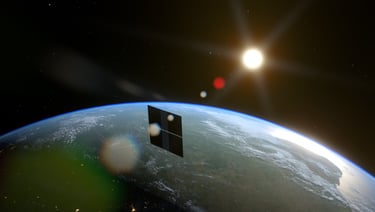Space Data Centers: Assessing the Feasibility and Future Outlook
An interesting post has been floating around on social media for the past couple of weeks about "Data Centers in Space". This concept of orbital data centers represents one of the most ambitious intersections of space technology and digital infrastructure. As terrestrial data centers consume approximately 1-2% of global electricity and face challenges around cooling, workforce, land use, and latency optimization, the space industry has begun seriously exploring whether outer space could host humanity's next generation of computing infrastructure. But how feasible is it?
AI AND ENERGYMOST RECENT
Sumedh Joshi
11/14/20254 min read


Current State of the Space Data Center Industry
The space data center industry exists primarily in the research and development phase, with several key players making significant investments. In 2024, the European Union allocated €2 million to study the feasibility of space-based data centers under the Advanced Space Cloud for European Net-zero emission and Data sovereignty (ASCEND) program. Thales Alenia Space leads this initiative, examining whether orbital facilities could achieve carbon neutrality despite launch costs. Meanwhile, private companies are pursuing varied approaches. Lumen Orbit, a 2024-founded startup, has raised venture capital to develop modular data centers for low Earth orbit (LEO), targeting deployment by 2029. Their approach focuses on leveraging solar power availability and passive cooling in the vacuum of space. NTT, the Japanese telecommunications giant, has partnered with SKY Perfect JSAT to explore satellite-based computing platforms. However, their initial focus remains on edge computing rather than full-scale data centers.
The market size remains speculative but potentially substantial. Current estimates suggest the terrestrial data center market exceeds $250 billion annually, with cloud computing infrastructure driving continuous growth. If space-based facilities could capture even 1% of specialized high-performance computing workloads, this would represent a multi-billion-dollar opportunity. However, these projections assume significant technological breakthroughs and cost reductions that have yet to materialize.
Technical Feasibility Assessment
The feasibility of space data centers hinges on several critical technical challenges and potential advantages.
The space environment offers unique benefits for data center operations. The vacuum of space provides perfect electrical insulation and eliminates the need for traditional air cooling systems. Solar energy availability in orbit reaches 1,361 watts/sq m continuously, unaffected by weather or day-night cycles. The microgravity environment could potentially enable new architectures for hardware design, though this remains largely theoretical. Additionally, the extreme cold of space (approximately 2.7 Kelvin in shadow) could theoretically provide exceptional cooling capabilities. However, the challenges are equally significant. Radiation poses a severe threat to electronic components, with cosmic rays and solar events capable of causing bit flips, component degradation, and system failures. While radiation-hardened components exist, they typically lag commercial processors by several generations in performance. Thermal management becomes paradoxically complex despite the cold environment. Without air for convection, heat dissipation relies entirely on radiation, requiring extensive radiator panels that add mass and complexity.
Data transmission presents another hurdle. Even with advanced laser communication systems, latency to LEO facilities would add 10-40 milliseconds round-trip, making them unsuitable for many real-time applications. Bandwidth limitations and the need for multiple ground stations further complicate operations. Hardware maintenance and upgrades, routine in terrestrial facilities, would require either expensive spacewalks or complete module replacement.
Cost Analysis
The economics of space data centers currently appear prohibitive for most applications, though costs are declining rapidly.
Launch costs dominate the initial capital expenditure. At current prices of approximately $2,000-5,000 per kilogram to LEO (using SpaceX's Falcon 9 or similar vehicles), a modest 10-ton data center module would cost $20-50 million just to launch. This excludes the hardware itself, which must be specially designed for space operations. Radiation-hardened servers cost 10-100 times more than commercial equivalents, and specialized cooling systems, power management, and structural components add substantial expense. Operating costs include station-keeping fuel for orbit maintenance, ground station operations, insurance (typically 5-10% of asset value annually), and eventual deorbiting expenses. A basic 1-megawatt space data center might require initial investments of $200-500 million, compared to $10-20 million for an equivalent terrestrial facility.
However, potential savings exist in certain scenarios. Elimination of cooling costs (which can represent 40% of terrestrial data center energy consumption) provides ongoing operational savings. Free solar power, after accounting for panel degradation and battery storage for eclipse periods, could eliminate electricity costs. For specific applications like satellite image processing or space-based research, proximity to data sources could reduce transmission costs and latency.
The business case improves for specialized applications where space-based processing offers unique advantages. These might include classified government operations requiring physical isolation, scientific computing for space missions, edge computing for satellite constellations, or cryptocurrency mining where energy costs dominate economics. As launch costs continue declining and as modular designs mature, the crossover point for economic viability could arrive within the next decade for niche applications.
Future Outlook
The space data center industry stands at a fascinating inflection point. While current technology and economics limit viability to specialized applications, rapid advances in launch systems, satellite technology, and growing concerns about terrestrial data center sustainability are creating new possibilities. The next five years will likely see continued experimentation with small-scale demonstrations and edge computing applications. Companies like Amazon (through Project Kuiper) and SpaceX (via Starlink) are already deploying massive satellite constellations that could benefit from orbital processing capabilities. As these networks mature, the infrastructure for supporting space-based computing will naturally develop.
By the 2030s, if launch costs achieve projected reductions and modular space station technologies mature, we might see the first operational space data centers serving specific high-value niches. The ultimate viability of space data centers will depend not just on technological advancement but on regulatory frameworks, international cooperation, and the evolution of computing needs. As artificial intelligence and quantum computing drive demand for specialized processing environments, and as sustainability concerns intensify around terrestrial facilities, the seemingly far-fetched idea of orbital data centers may transform from science fiction to economic necessity. The industry remains nascent, but the convergence of declining space access costs and exploding computational demands suggests that computing's future may indeed lie among the stars.
Connect
info@energizetomorrowus.com
© 2025. All rights reserved.


